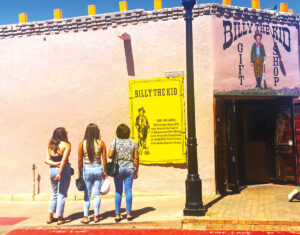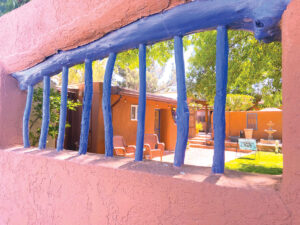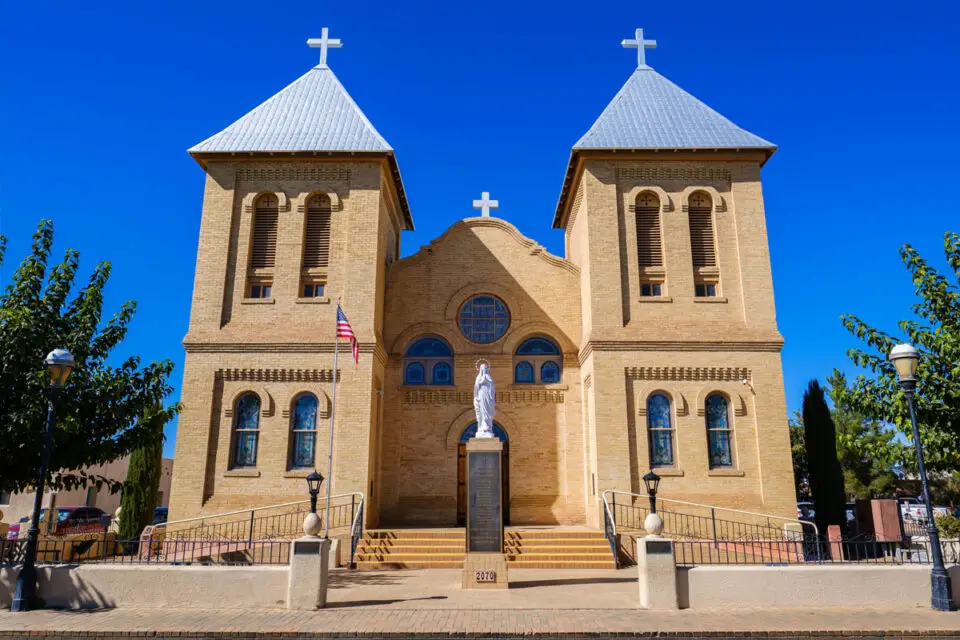We are standing in the grassy plaza in historic Mesilla, population 1,780, just four miles from downtown Las Cruces. The intense, late-April New Mexico sun has sent us seeking shade on this delightful little piece of real estate as we wait for our guide.
The town square, the enormous church looming over it and the adobe buildings surrounding it are reminiscent of so many villages elsewhere in the state and south of the border, but something is askew.
Mural artist, historian and tour guide Preciliana Sandoval provides an answer to our unasked question.
“The Basilica San Albino is a French Gothic-style cathedral because the priest who was the pastor at the time this church was built (in 1906) was French,” explains the lifelong Mesilla resident, who regularly enthralls visitors with stories about the town, its early and current inhabitants, and the occasional ghost.
The church also was named after a French saint, Albinus of Angers (Albino in Spanish).
The original San Albino Church was erected in 1852 on this same site when Mesilla was part of Mexico, according to Alexandra McKinney, an educator and historian with New Mexico Historic Sites.
Back then, the Catholic Church regularly assigned French priests to its parishes. This remained so for decades, even after the Gadsden Purchase in 1854, a watershed moment for Mesilla.

Also called the Treaty of Mesilla, the Gadsden Purchase dictated that the United States pay Mexico $10 million (about $250 million in 2023 dollars) for land that is now southern Arizona and the southwest corner of New Mexico.
Suddenly Mesilla was no longer a part of Mexico, and even though the town’s Mexican roots are deep, sometimes it takes a little doing to bring forth the obvious.
For instance, 15 years ago, Sandoval says, she and several women wanted to stage a Dia de los Muertos (Day of the Dead) celebration at the basilica, but “the (parish priest) wouldn’t let us have a celebration, so we rented the plaza and turned it into a cemetery.
“That first year, there were five women and a little red wagon with skeletons in it and a few other people. Now, about 5,000 show up every year for a two-day festival.”
Some are working hard to preserve Mesilla’s history and uniqueness, including residents who are fighting to prevent the installation of a 60-foot cellphone tower in their historic district.
“We have a lot of newcomers,” Sandoval says. “They care about the environment.”

Mesilla will soon have a new venue to showcase its history — the Taylor-Mesilla Historic Site, “one of the oldest (buildings) on the Old Mesilla Plaza, with the earliest portions dating to the 1850s,” says McKinney, who is tasked with converting the home into a museum.
In 2003, the Taylors donated their home, two of the attached stores and their collection of Spanish Colonial, Mexican, Native and New Mexican artwork, furniture, textiles and pottery to the State of New Mexico.
Listed on the National Register of Historic Places, the home provides “a remarkable opportunity to highlight the importance of Southern New Mexico in the state’s history,” McKinney says.
The opening date is to be announced, but you can follow updates at facebook.com/groups/taylormesillahistoricpropertyfacebookcommunity.
For more photos and discussion, visit newmexico.org/places-to-visit/regions/southwest/old-mesilla and facebook.com/elouise.ondash.



